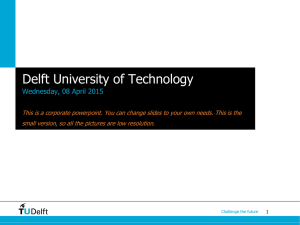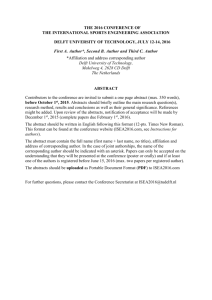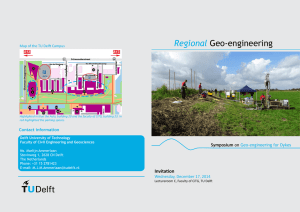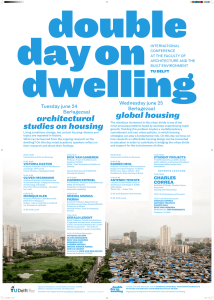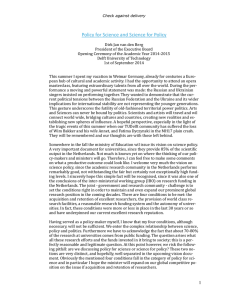Sustainable reuse of buildings, the Dutch approach - Kennis
advertisement
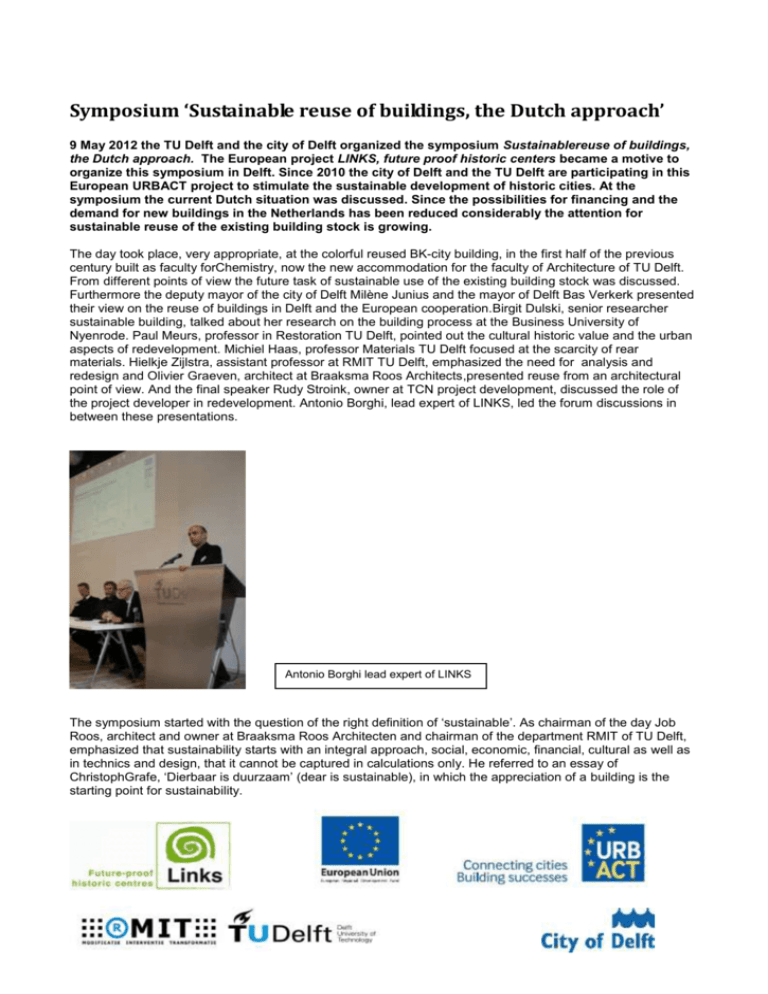
Symposium ‘Sustainable reuse of buildings, the Dutch approach’ 9 May 2012 the TU Delft and the city of Delft organized the symposium Sustainablereuse of buildings, the Dutch approach. The European project LINKS, future proof historic centers became a motive to organize this symposium in Delft. Since 2010 the city of Delft and the TU Delft are participating in this European URBACT project to stimulate the sustainable development of historic cities. At the symposium the current Dutch situation was discussed. Since the possibilities for financing and the demand for new buildings in the Netherlands has been reduced considerably the attention for sustainable reuse of the existing building stock is growing. The day took place, very appropriate, at the colorful reused BK-city building, in the first half of the previous century built as faculty forChemistry, now the new accommodation for the faculty of Architecture of TU Delft. From different points of view the future task of sustainable use of the existing building stock was discussed. Furthermore the deputy mayor of the city of Delft Milène Junius and the mayor of Delft Bas Verkerk presented their view on the reuse of buildings in Delft and the European cooperation.Birgit Dulski, senior researcher sustainable building, talked about her research on the building process at the Business University of Nyenrode. Paul Meurs, professor in Restoration TU Delft, pointed out the cultural historic value and the urban aspects of redevelopment. Michiel Haas, professor Materials TU Delft focused at the scarcity of rear materials. Hielkje Zijlstra, assistant professor at RMIT TU Delft, emphasized the need for analysis and redesign and Olivier Graeven, architect at Braaksma Roos Architects,presented reuse from an architectural point of view. And the final speaker Rudy Stroink, owner at TCN project development, discussed the role of the project developer in redevelopment. Antonio Borghi, lead expert of LINKS, led the forum discussions in between these presentations. Antonio Borghi lead expert of LINKS The symposium started with the question of the right definition of ‘sustainable’. As chairman of the day Job Roos, architect and owner at Braaksma Roos Architecten and chairman of the department RMIT of TU Delft, emphasized that sustainability starts with an integral approach, social, economic, financial, cultural as well as in technics and design, that it cannot be captured in calculations only. He referred to an essay of ChristophGrafe, ‘Dierbaar is duurzaam’ (dear is sustainable), in which the appreciation of a building is the starting point for sustainability. The deputy mayor Milène Junius gave her view on the sustainable reuse of buildings in Delft and especially mentioned the policy of Delft to avoid vacancy and to stimulate temporary reuse. Furthermore she emphasized the cultural meaning of reuse and the importance of cheap temporary locations for experiment and creativity. Birgit Dulski showed that in the Netherlands20% of the building stock exists of traditional buildings, built before 1940. Especially for this part a considerable energy profit would be possible. She noticed a growth of experimental extremely low energy renovation. Nevertheless these projects, driven by high ambitions, are relatively expensive. She stated that too high ambitions of environmentalists versus a sometimes too conservative view of conservationists impede proper communication. She pled for a more pragmatic approach, often ‘tailor-made’. Small, specific and effective adjustments of buildings can produce a much higher overall profit. Furthermore she pled for effective regulations and stimulating policies to enhance the chance for success. The second speaker,Paul Meurstalked about reuse on an urban scale. He presented the building as part of a collective understanding of the space and the identification of inhabitants with their surroundings. He mentioned that the high number of listed buildings in the Netherlands, 1,7% of the total building stock, forms quite an assignment to maintain in good condition. Furthermore he asked for attention for the public space as a binding element in the city. Also in the restructuring of the postwar modernistic areas the revaluation of the public space is a key issue. These neighborhoods from the fifties have plenty of public green space but lack solutions for the current need for parking places. The redesign of the public space could restore the original quality of these neighborhoods. Meurspled for a more integral approach in general: an open and continuous dialogue between all stakeholders. The re-used building BK city Olivier Graeven and HielkjeZijlstra approached the demand for sustainable reuse as anarchitectonic assignment. From the analysis of the surroundings, the history and the building they presented design solutions for renovation and reuse of a building. Zijlstra had elaborated this in her so called ABCD method in which ‘understanding the building’ is fundamental, from context to detail. She showed an adjustment of a concrete façade panel in the reconstruction neighborhood Jeruzalem, Amsterdam. The panel that once was the visual expression of modern standardization and mass production, could only meet the modern insulation standards by adapting its thickness. By doing so the typical expression of the design of the dwellings could be preserved in the area that has now been listed as a national monument. The question remains if such an expensive and radical renovation of an existing building can be financially affordable. Olivier Graven presented a redesign of the mail sorting building TPG Post at Holland Spoor, The Hague. By placing a huge volume on top of an existing building, the originallandmarkeffect of the once futuristic building was brought back into its surroundings. He approached the redesign of the building as an evolutionary process that allows it to grow and to change, in a natural, logical and poetical way. Michiel Haasquestioned our understanding of sustainability by discussing the scarcity of materials instead of energy. The energy of the sun is endless but the availability of scarce materials for our products is ending. He showed how this scarcity of materials influencesthe dependency in between countries and continents. For example the production of advanced technology products that are largely owned by Chinese entrepreneurs in Africa. From this logic he argued that redundant buildings should not be considered as waist but as material suppliers. That we should demolish in a sustainable way. In this view throwing away materials is a waste of energy. In the ideal future situation we might think of materials that do not have any environmental impact and grow again during their lifespan. He introduced the concept of ‘zeromaterials’, in analogy with zero energy concepts. As final speakerRudy Stroinkpresented his vision on the future development of the Netherlands. He started with the conclusion that estate development and market in the Netherlands are derailed. He made a clear distinction between the crisis and the problems in the estate market, taking into account that the latter will not be easily overcome. He stated that the vacancy in the office market is now 20% and will raise in the future to a 40 to 50%. In short: we have more than enough buildings. As a consequence of this he expects the prices of the stock to fall. Thereafter he showed the TCN concept of redevelopment. TCN invests in non-profitable buildings by finding new users that are looking for a cheap workplace, for example small creative industries and freelancers. These companies are compensated by additional services and a sense of communal belonging for example with good coffee, parking space or child care. So he invests mainly in the social community of renters, instead of in buildings only. He viewed the different actors in building process as parties that should create clearly defined conditions to realize new developments. In the future development of the Netherlands he expects the government to develop according to the American model, in which the role of the government as an investor will diminish. Stroinkalso stated that an integral approach is essential for reuse. All stakeholders should perform according to their role in the processand stimulatethe development process. To create out of their own specialism fruitful conditions for the other stakeholders. Thus transforming projects into platforms for original creations. The introduction of the American model in Europe, as RudyStroinkmentioned, gave rise to some discussion. Emmanuel Moulin, director of the URBACT Secretary, asked about the Dutch debate around social housing since this issue was not mentioned in the debate. This might have been due to the typical Dutch situation of the major influence of the housing construction associations and needed some explanation for the international visitors. Other participants in the room asked if for the transformation of lesser profitable locations the developing role of the government would still be needed. At the end of the day FrédériqueCalvanus, lead partner of LINKS from the French city of Bayonne, presented the goals of the LINKS project. She stated that in the rest of Europe the stock of traditional buildings is even bigger (30%) and asked for more attention for knowledge of the traditional building physics and damp-open properties of these buildings. In the end of the dayBas Verkerk, mayor of Delft, reminded us on the fact that the 9th of May is also the day of Europe. The mayor stressed the importance of European exchanges and strongly advocated the social European alternative for the individualistic American politics and collective Asian market, taking the ‘Dutch approach’ to an intercontinental level. After all the symposium gave an impression how scarcity can and should actuate the formulation of new ideas and insights. Thinking about a sustainable future the integral approach is crucial. The symposium attempted to draw some outlines of this future. Ilse Rijneveld, Wim van Unen, city of Delft, July 2012
